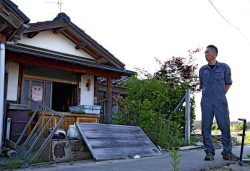Restart of Shika Nuclear Power Plant ‘Likely to Take Years’; Seismic Activity During Noto Quake Possibly Greater Than Expected

Hokuriku Electric Power Co.’s Shika Nuclear Power Station in Ishikawa Prefecture is seen on Jan. 3.
18:10 JST, January 29, 2024
The screening process to restart a reactor at Hokuriku Electric Power Co.’s Shika nuclear power plant will likely be prolonged, as a belt of active faults may have seen seismic activity over a larger area than expected during the Noto Peninsula Earthquake.
The Nuclear Regulation Authority (NRA) said it would take several years to determine the impact of the faults belt on the nuclear plant.
The Shika Nuclear Power Station has two reactors, which were shut down in 2011 after the accident at Tokyo Electric Power Company Holdings Inc.’s Fukushima No. 1 nuclear power plant. In 2014, Hokuriku Electric applied for a safety screening with the aim of restarting its No. 2 reactor.
An NRA screening establishes a “basic earthquake ground motion” — the maximum level of shaking that could be caused by active faults around a plant — and this is factored into the design of a nuclear power plant’s quake resistance.

Much time has been spent checking whether faults under the station’s premises were active. The Jan. 1 earthquake occurred just when the screening process was about to move on to check faults located in the surrounding area.
Screening materials prepared by Hokuriku Electric presented the possibility that a 96-kilometer-long belt of active undersea faults off the northern Noto Peninsula would move at a time of an earthquake.
However, the government’s Earthquake Research Committee said that in the Jan. 1 earthquake, the range of seismic activity may have extended to about 150 kilometers due to the interlocking of other active undersea faults. The longer an active fault is, the larger the magnitude of an earthquake can be. The committee’s findings could shake the basis of Hokuriku Electric’s data.
There are many other active faults around the nuclear station, both on land and under the sea. Some experts even say the New Year’s quake has made active faults off the town of Shika’s coast — which are located near the power plant — more susceptible. If the effect of the active faults remain unknown, the Shika plant’s seismic design will not be finalized and its operations will remain suspended.
NRA Chairman Shinsuke Yamanaka said the watchdog had to wait for inspections by the national government and other experts on those active faults.
Checking them “will probably take years, and the [following] screening process even longer than that,” Yamanaka said.
Unforeseen troubles
A tremor measuring upper 5 on the Japanese intensity scale hit the Shika power station during the Jan. 1 earthquake. Although no serious safety problems occurred, there were some unforeseen problems.
The plant has a total of 1,657 nuclear fuel rods, which must be cooled in the fuel pool using an external power supply. However, the quake damaged several transformers at the plant, rendering two of the five power grids inoperable. Full restoration is expected to take more than six months.
Hokuriku Electric has been diversifying its power supply systems, based on lessons learned from the Fukushima plant accident, in which all external power sources were lost. It also has emergency diesel generators and other equipment ready.
However, an NRA member said the agency “had not envisioned a scenario” in which the plant cannot receive power due to transformer damage.
Hokuriku Electric also revised some of the damage-related information it had previously released.
An employee reported they heard an explosion and smelled a burnt odor in the No. 2 reactor on the evening of Jan. 1. Chief Cabinet Secretary Yoshimasa Hayashi announced that “a fire had broken out in a transformer and been extinguished.”
But what the worker actually heard and smelt was equipment operating and the smell of oil.
The power company also later revised the amount of oil leaking from the transformer and its explanation of water level fluctuations caused by the tsunami. A company spokesperson said, “Information sharing within the company was insufficient.”
Hiroshi Miyano, a former visiting professor of nuclear reactor systems at Hosei University, said, “We should identify the lessons learned from this earthquake in terms of both infrastructure and personnel — such as damage to transformers, ways information should be disseminated, and staffing on the day — before sharing them with other power companies.”
"Society" POPULAR ARTICLE
-

M4.9 Earthquake Hits Tokyo, Neighboring Prefectures
-

Israeli Tourists Refused Accommodation at Hotel in Japan’s Nagano Pref., Prompting Protest by Israeli Embassy and Probe by Prefecture
-

M7.5 Earthquake Hits Northern Japan; Tsunami Waves Observed in Hokkaido, Aomori and Iwate Prefectures
-

Tsukiji Market Urges Tourists to Avoid Visiting in Year-End
-

High School in Kyoto Says Students Shoplifted during Recent School Trip to Bali, Indonesia
JN ACCESS RANKING
-

Tokyo Economic Security Forum to Hold Inaugural Meeting Amid Tense Global Environment
-

Keidanren Chairman Yoshinobu Tsutsui Visits Kashiwazaki-Kariwa Nuclear Power Plant; Inspects New Emergency Safety System
-

Imports of Rare Earths from China Facing Delays, May Be Caused by Deterioration of Japan-China Relations
-

University of Tokyo Professor Discusses Japanese Economic Security in Interview Ahead of Forum
-

Japan Pulls out of Vietnam Nuclear Project, Complicating Hanoi’s Power Plans




























